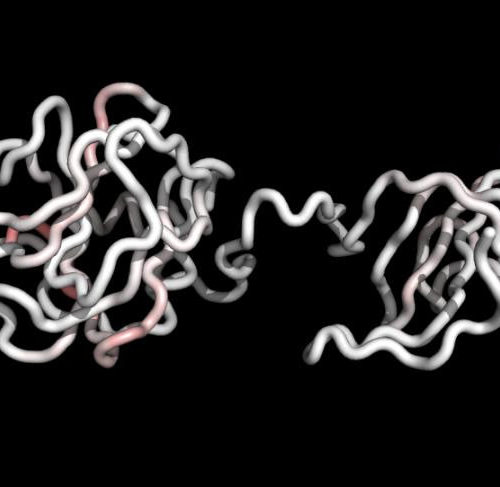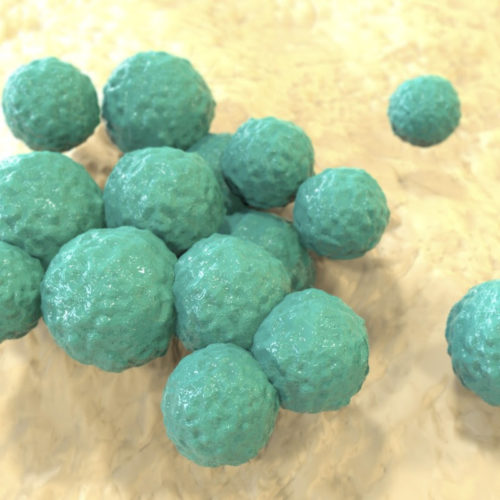By Dr. Priyom Bose, Ph.D.Reviewed by Lily Ramsey, LLM The global impact of antibacterial resistanceDrug-design strategies to overcome antibacterial resistanceFuture research outlook References Antibacterial resistance occurs when antibiotics fail to treat bacterial infections. This incidence is considered one of the top global health threats, stemming from the misuse or overuse of antibiotics in humans and animals.1 Image Credit: i...
Tag: <span>antibacterial</span>
Dartmouth-led team engineers new treatment for drug-resistant bacterial infections
THAYER SCHOOL OF ENGINEERING AT DARTMOUTH A MOLECULAR MODEL OF THE F12 BIOTHERAPY SHOWS THE FOLD OF ITS POLYPEPTIDE BACKBONE. RESIDUAL T CELL EPITOPES ARE MAPPED ONTO THE STRUCTURE AND COLORED FROM WHITE (NO EPITOPES). The Centers for Disease Control and Prevention (CDC) has prioritized finding effective treatment of Methicillin-resistant Staphylococcus aureus (MRSA), one of...
Cellulose wound dressing uses peptides to kill bacteria
By Ben Coxworth August 11, 2020 Staphylococci bacteria proved to be no match for the peptide-boosted cellulose fibers katerynakon/Depositphotos VIEW 1 IMAGES Although it’s vitally important to keep wounds free of harmful bacteria, antibacterial ointments have to be regularly reapplied, requiring bandages to be removed. A new wound dressing, however, is claimed to continuously kill...
‘Good’ virus for common infection
Antibiotic-resistant diabetic foot ulcer application FLINDERS UNIVERSITY Australian researchers have shown how viruses can be used to save lives, developing the potential use of bacteriophages in bandages to treat life-threatening golden staph infections which may not respond to traditional antibiotics. Targeting multidrug-resistant Staphylococcus aureus (‘golden staph’) in diabetic foot ulcers, Flinders University microbiology researchers have...
HOW SOAP WORKS TO KEEP YOU HEALTHY
Washing your hands with plain soap and water can destroy the coronavirus that causes COVID-19. But how does soap work to keep you healthy? “There are so many unknowns about this pandemic that are driving fear and leading to irrational actions, like panic-buying of toilet paper,” says Bill Wuest, an associate professor in the chemistry...
Women exposed to common antibacterial chemical more likely to break a bone
First study of its kind links triclosan to human bone health THE ENDOCRINE SOCIETY WASHINGTON–Women exposed to triclosan are more likely to develop osteoporosis, according to a study published in the Endocrine Society’s Journal of Clinical Endocrinology & Metabolism. Triclosan is an endocrine-disrupting chemical being widely used as an antibacterial in consumer goods and personal care products, including soaps, hand sanitizers, toothpaste, and mouthwash. A person can...
Antibacterial polymers
Surprising antibacterial activity and selectivity of hydrophilic phosphonium polymers WILEY Artificial polymers, like antibiotic peptides, need both hydrophobic and hydrophilic domains in their molecular structure to exert antibacterial activity. Now, researchers from Canada have synthesized a phosphonium polymer that challenges this view. As outlined in the journal Angewandte Chemie, their polymer salt contained no hydrophobic alkyl chains but...
Controversial antibacterial ingredient now linked to inflammation and cancer
In the early 1970s, the chemical triclosan began to appear in a multitude of products. From soaps and toothpaste to cleaning supplies and pesticides, triclosan was reportedly an effective antibacterial and antifungal compound. Pretty much immediately after it started appearing in household products, the FDA commenced investigating the chemical’s safety profile, but it wasn’t until...
Researchers define target and mechanism of antibacterial drug fidaxomicin (Dificid)
Fidaxomicin (cyan) binds to RNA polymerase (gray) at the base of the clamp, a part of RNA polymerase that swings open by 17 degrees to allow RNA polymerase to bind to DNA and swings closed to allow RNA polymerase to hold onto DNA (open clamp A team of Rutgers University and international scientists have determined...


